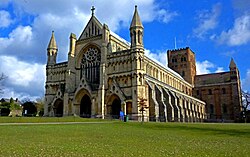Diocese of St Albans
| Diocese of St Albans Church of England | |
| Province: | Canterbury |
|---|---|
 | |
| Bishop: | Dr Alan Smith |
| signs as: | St Albans |
| Cathedral: | St Albans Cathedral |
| Organisation | |
| Suffragan bishop(s): |
Bishop of Bedford Bishop of Hertford |
| Archdeaconries: | Bedford, Hertford, St Albans |
| No. of parishes: | 336 |
| Details | |
| Website: | http://www.stalbans.anglican.org |
The Diocese of St Albans forms part of the Province of Canterbury in the Church of England. It covers Hertfordshire and Bedfordshire.
The diocese is home to more than 1.6 million people. The communities served by the Church in the Diocese range from small villages and hamlets to major urban centres such as Barnet, Luton, Bedford, Watford and Hemel Hempstead.
History
The Diocese of St Albans was founded by an Order in Council in April 1877, implementing the Bishopric of St Albans Act 1875. The first Bishop of St Albans was Thomas Legh Claughton, who served from 1877 to 1890.
The diocese was established from parts of the large Diocese of Rochester, extending the new Bishop's jurisdiction over more than 600 parishes in the two counties of Essex and Hertford.
In 1914, the new Diocese of Chelmsford was formed, removing Essex from the St Albans diocese. A few months later the county Archdeaconry of Bedford was added from the Diocese of Ely, thereby providing the diocese substantially with its current boundaries.
The suffragan Bishopric of Bedford was revived in 1879 and again in 1935, and another, Hertford was created in 1968.
Cathedral
The seat of the Bishop is in the City of St Albans, at St Albans Cathedral.
The cathedral is a grand building dominating this modest town. The building itself dates from 1077 and was an abbey church, part of St Albans Abbey, until the Dissolution of the Monasteries in 1539, whereafter it was abandoned until bought by the town in 1553 and then served as a parish church until its elevation to cathedral status in 1877. It was the presence of the cathedral which propelled St Albans itself to be granted city status.
Current structure
The diocese currently includes:
- the county of Bedford
- the county of Hertford
- the village of Swineshead in the county of Huntingdon (detached)
The Diocese is overseen by the Bishop of St Albans, whose 'cathedra' (or chair) is in St Albans Cathedral. He is supported in his pastoral work in the diocese by two suffragan bishops, the Bishops of Hertford and Bedford, and by three Archdeacons.
The diocese is divided into three Archdeaconries:
- the Archdeaconry of St Albans:
- includes the Deaneries of Aldenham, Berkhamsted, Hemel Hempstead, Hitchin, Rickmansworth, St Albans, Watford and Wheathampstead
- the Archdeaconry of Bedford:
- includes the Deaneries of Ampthill, Bedford, Biggleswade, Dunstable, Elstow, Luton, Sharnbrook and Shefford
- the Archdeaconry of Hertford:
- includes the Deaneries of Barnet, Bishop's Stortford, Buntingford, Cheshunt, Hertford & Ware, Stevenage, and Welwyn & Hatfield
The Archdeaconry of Hertford was created in January 1997 from the eastern parts of the Archdeaconry of St Albans, which at the time was one of the largest archdeaconries in England.
The diocesan offices are located in Holywell Hill in St Albans.
Bishop of St Albans
The current Bishop of London is Dr Alan Smith, who was appointed in 2009.
The Bishop's residence is Abbey Gate House, Abbey Mill Lane, St Albans.
List of bishops
| Tenure | Incumbent | Notes |
|---|---|---|
| 1877-1890 | Thomas Claughton | Translated from Rochester |
| 1890-1902 | John Festing | |
| 1903-1920 | Edgar Jacob | Translated from Newcastle |
| 1920-1944 | Michael Furse | Translated from Pretoria, South Africa |
| 1944-1950 | Philip Loyd | Translated from Nasik, India |
| 1950-1970 | Edward Jones | |
| 1970-1980 | Robert Runcie | translated to Canterbury on 25 February 1980 |
| 1980-1995 | John Taylor | |
| 1995-2009 | Christopher Herbert | |
| 2009-present | Alan Smith | Translated from Shrewsbury (Lichfield) |
Outside links
References
| Dioceses of the Church of England |
|---|
|
Province of Canterbury: |